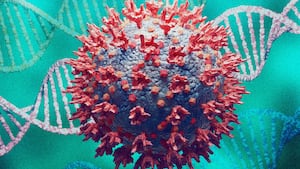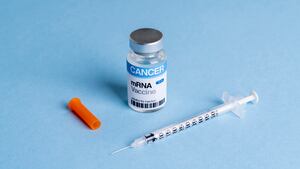In a recent survey of tens of thousands of American adults in all 50 states, about half reported experiencing a previous or ongoing COVID-19 infection. Those findings complement two reports from earlier last year that suggested between 42 and 58 percent of adults, respectively, had been infected with the virus at some point.
But that’s accounting for at least one infection. The proportion of Americans getting COVID again is a tougher nut to crack, since we lack adequate public health surveillance and viral testing to deduce concrete numbers on reinfections. But even without the perfect epidemiological data, we know they are on the rise.
What we haven’t figured out yet, however, is what reinfections mean for living with COVID in the long run.
“There are several reasons for the high numbers of repeat infections that we’ve seen for COVID,” Scott Pauley, a Centers for Disease Control and Prevention spokesperson, told The Daily Beast in an email. “First, the numbers of infections from COVID continue to be high, and a lot of people who had COVID earlier in the pandemic are now being exposed again. Second, immunity gets weaker over several months, and the risk of a repeat infection increases over time. Third, COVID continues to change and the immune response is often weaker against new variants.”
At some level, this isn’t surprising. Before he stepped down as the director of the National Institute of Allergy and Infectious Diseases, Anthony Fauci predicted that SARS-CoV-2 infections might become a more-than-annual occurrence—though over time, his hope was that COVID would become a seasonal illness.
That’s less than ideal for a number of reasons (cough, cough, Long COVID and a consistently overburdened health-care system.) But at least we have experience with how to deal with seasonal viral threats, like the flu. Unfortunately, it’s still common for people to come down with COVID multiple times a year. So what would need to happen for COVID to transition into an annual infection? And what’s special about new Omicron subvariants, like XBB.1.5 and BQ.1.1, that had led the World Health Organization to warn of higher reinfection risks, as compared to other Omicron sublineages? Basically, what gives?
I had ample time to ponder these questions when, following a certain parent company’s holiday party, I was isolating at home with my second confirmed COVID-19 infection of the year (just eight months after my first). According to Preeti Malani, an infectious disease physician at the University of Michigan, my experience follows specific trends she’s been seeing:
“I think younger people are at higher risk of reinfection because they have more exposure—that’s just been my observation,” Malani told The Daily Beast. “I’m the mother of young adults, so what I tell my own kids is to find a balance.” Take part in the activities that connect them to other people, she suggests, but be mindful of their level of exposure before important events that involve elderly family members or others at higher risks for worse outcomes from an infection.
Observational studies also seem to back this finding up. One study from last August published in JAMA Network Open analyzed the proportion of reinfections from over 11,000 people in Iceland who tested positive for COVID-19 during the country’s first Omicron wave. While the researchers observed reinfections among 11.5 percent of all positive cases, the proportion of reinfections was highest among 18-to-29-year-olds, at a bit over 15 percent. Still, these results may have been affected by the fact that only about one quarter of the previously infected people in the study had been vaccinated, compared to 71.1 percent of the Icelandic population at the time.
Still, “Our results suggest that reinfection is more common than previously thought,” the researchers wrote in the study.
U.S. data have even more holes. Currently, the Centers for Disease Control and Prevention does not publish case counts of reinfections as part of their COVID Data Tracker. Individual state health departments publish data on reinfection cases, hospitalizations, and deaths, but these statistics should be taken with a grain of salt, Malani said.
“I don’t know how accurate those numbers are because there’s very little contact tracing happening at large scales now,” Malani said. Reinfection numbers are almost certainly undercounts, since they rely on people having at least two confirmed COVID-19 cases by definition. This means that they would need to have tested positive through a medical provider or reported an at-home positive test twice. Considering that many people may not test at all, or take an at-home test and fail to report it, reinfection rates are essentially unknown.
‘Original Antigenic Sin’
It’s settled that reinfections are occurring. How SARS-CoV-2 can keep escaping immunity is an ongoing research question, but early data suggest that Omicron subvariants seem to have a knack for slipping by an immune system bolstered through vaccination, previous infection, or both.
Researchers in China published a small study this month in The Lancet Infectious Diseases that sampled antibodies from 15–20 people previously infected with Delta and early Omicron subvariants of SARS-CoV-2, and tested their power to bind and block infection from emerging Omicron subvariants. They found that only about 40 percent of samples taken from people with Delta breakthrough infections were able to incapacitate BQ.1 and BQ.1.1 subvariants. Omicron-infected individuals’ samples fared better, but did not uniformly neutralize the two newer subvariants, leading the researchers to conclude that BQ.1 and BQ.1.1 “can pose a challenge to immunity induced by vaccination or infection.”
A concept known as immune imprinting may be at play for these Omicron subvariants. Also called “original antigenic sin” (which sounds a lot more foreboding), the process refers to a person’s immune system relying on earlier, outdated memory to fight off an infection, rather than more recent and relevant information. And Omicron subvariants definitely look different than their predecessors: They have dozens of mutations in their spike protein, the part of the virus that binds to human cells and that antibodies target. One study from last June, published in Science, found that an Omicron infection did not provide an immunity boost when triply vaccinated study participants had been previously infected with an earlier variant.
“Getting infected with Omicron does not provide a potent boost to immunity against reinfection with Omicron in the future,” study lead author and Imperial College London immunology researcher Rosemary Boyton said in a press release at the time.
Of course, all this viral mutation is made possible by idiosyncrasies of the virus itself as well as its high prevalence. Simply put, the more of a virus there is, the greater the odds a mutation randomly occurs.
As such, it’s not clear when COVID-19 infection will become an annual occurrence. It’s important to remember that these dynamics depend on infection rates internationally, not just in the U.S., Malani said. Over the coming weeks, we will start to see how China’s ongoing surge influences viral spread around the world. In the long term, though, reaching a détente with COVID will hinge upon widespread protection.
“The way we move forward eventually, I think, is that everyone is either vaccinated or has had an infection, or both,” she said.









